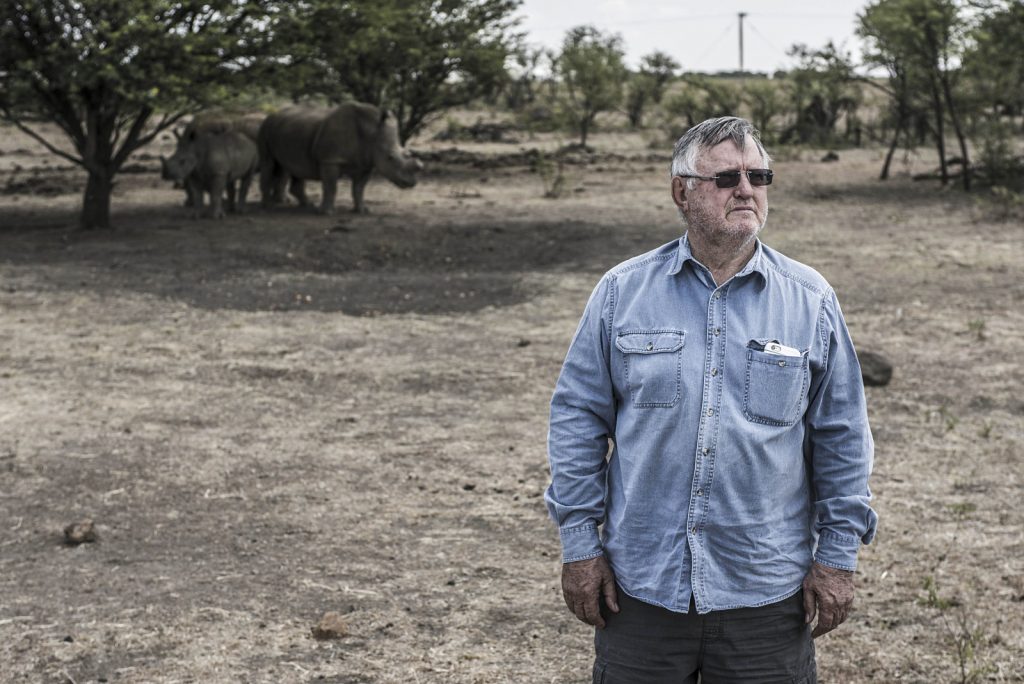Professor James Larkin argues that his radical method will stop the illegal rhino horn trade, while conservationists strongly disagree. (Photo by Gallo Images / Rapport / Conrad Bornman)
University of Witwatersrand Professor James Larkin offers no apologies that his proposed experiment to inject live rhino’s horns with radioactive materials to discourage poaching may destroy the legal rhino horn trade, including rhino ranchers’ businesses.
Concerned conservationists say this experiment is an example of using extreme solutions instead of simple and practical ones to manage problems.
On the one hand, rhino poaching has been kept in reasonable check by diligent guards and strong fencing. On the other hand, exposure to radioactivity can cause nausea, vomiting, hair loss, diarrhoea, central nervous system damage and death. It also causes DNA damage and raises the risk of cancer, particularly in young children and foetuses.
However, Larkin, director of the radiation and health physics unit at Wits, said that his Rhisotope project aims to inject rhino horns with small quantities of radioactive material that he believes will be “harmless”.
“Putting radioactive material into the rhino horn is the idea of the [Rhisotope] project to devalue the horn and make people uninterested in it,” said Larkin.
Looking into Larkin’s idea
It’s a “good thing,” noted Godfrey Harris, managing director of the Los Angeles-based Ivory Education Institute. He said Larkin “has no mandate or the ability to force anybody to accept any element of this nutty scheme”.
“It’s entirely the decision of the owners of the rhino,” said Larkin. “It’s entirely up to them not to accept [my proposal] but they must face the consequences of rhino poaching if they don’t accept it.”
Harris said: “The rhino ranchers have built large, growing and vibrant white rhino herds despite the rhino poaching threats.”
 John Hume, hotel magnate and rhino farmer, poses for a photograph on his ranch outside Johannesburg, South Africa Photographer: Waldo Swiegers/Bloomberg via Getty Images
John Hume, hotel magnate and rhino farmer, poses for a photograph on his ranch outside Johannesburg, South Africa Photographer: Waldo Swiegers/Bloomberg via Getty Images
Larkin noted that the likes of South Africa-based white rhino producer John Hume “created a catastrophic business model” by raising a large herd whose horns they might never trade in the future.
Meanwhile, the chairman of South Africa’s Private Rhino Owners Association (PROA), Pelham Jones said: “We are deeply concerned that the project, while well intended, is in conflict with our rights as owners to sustainable utilisation as is entrenched in the Constitution.”
“Trade in rhino horn will generate much-needed conservation revenue which, in the long term, will assist local communities with job creation and transformation,” said Jones. “The Rhisotope project is in total conflict with this proposal as the horns will lose all commercial value.”
Problems with trade
Reacting to Larkin’s proposed experiment, the chief executive of South Africa-based True Green Alliance, Ron Thomson said: “I am absolutely aghast at the lack of perspicacity [perception] on the part of Larkin’s understanding about the wildlife management needs in Africa today. His idea panders to the animal rights ideology which is dominated by one word ‘prohibition’. He wants to stop the trade. We want to legalise trade.”
Larkin was quoted in the media as saying that the Rhisotope project is receiving “overwhelming support”. Yet he declined to disclose the names of organisations and governments supporting him. Harris noted that if Larkin had the support that he claims, he would identify any agency “other than himself who believes this is a viable scheme”.
Jones added: “We have seen a similar concept to infuse a horn with poison. But research showed that it is not possible to do this. This action did not prevent poachers from killing rhinos that had been marked as having been treated with poison.”
Going ahead
Despite the criticism, Larkin claims to be proceeding with the Rhisotope experiment.
“We are at the early stages of discussion with many stakeholders,” said Larkin. “It [support for the Rhisotope project] is coming from all sorts of different places.”
One of Zimbabwe’s top conservationists and former director general of Zimbabwe Parks and Wildlife Management Authority, Morris Mtsambiwa, said that he would not welcome the Rhisotope project in Zimbabwe.
“I think one day Zimbabwe should be able to trade in its rhino horns and therefore injecting radioactive material [into them] is not good,” said Mtsambiwa. “I would not encourage Zimbabwe to support such a proposal. Sounds dangerous already. Trade in rhino horn has to take place sustainably if we are to benefit from rhino conservation otherwise there would be no incentive to conserve rhinos.”
Less invasive ways
Concerned conservationists have said that a rhino’s horn is a renewable resource that regrows, very much like a human’s fingernail, and is harvestable every two years or so, without needing to kill the rhino. It can be trimmed with no pain or harm to the animal. It is widely feared, however, that the Rhisotope initiative could destroy the potential to ever trade and benefit from rhino horn for conservation and development purposes in Africa.
Larkin has seemingly placed himself firmly in the anti-rhino trade movement. With the international ban on rhino horn trade failing to stop poaching, conservationists have reacted by saying that in Africa if people don’t benefit from the wildlife they would not see the need to conserve it. Therefore, they argue that trade, not aid, will save the rhino.
“Injecting radioactive material into our rhinos would make the rhino, as a species, inimical,” said Thomson. “It will negate the use of legal trade [to] ‘save’ our rhinos by making the species valuable to mankind.”